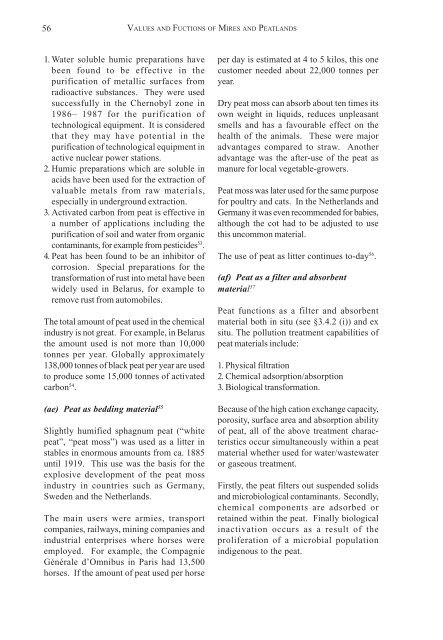wise use of mires and peatlands - Peatland Ecology Research Group
wise use of mires and peatlands - Peatland Ecology Research Group
wise use of mires and peatlands - Peatland Ecology Research Group
You also want an ePaper? Increase the reach of your titles
YUMPU automatically turns print PDFs into web optimized ePapers that Google loves.
56 VALUES AND FUCTIONS OF MIRES AND PEATLANDS1. Water soluble humic preparations havebeen found to be effective in thepurification <strong>of</strong> metallic surfaces fromradioactive substances. They were <strong>use</strong>dsuccessfully in the Chernobyl zone in1986– 1987 for the purification <strong>of</strong>technological equipment. It is consideredthat they may have potential in thepurification <strong>of</strong> technological equipment inactive nuclear power stations.2. Humic preparations which are soluble inacids have been <strong>use</strong>d for the extraction <strong>of</strong>valuable metals from raw materials,especially in underground extraction.3. Activated carbon from peat is effective ina number <strong>of</strong> applications including thepurification <strong>of</strong> soil <strong>and</strong> water from organiccontaminants, for example from pesticides 53 .4. Peat has been found to be an inhibitor <strong>of</strong>corrosion. Special preparations for thetransformation <strong>of</strong> rust into metal have beenwidely <strong>use</strong>d in Belarus, for example toremove rust from automobiles.The total amount <strong>of</strong> peat <strong>use</strong>d in the chemicalindustry is not great. For example, in Belarusthe amount <strong>use</strong>d is not more than 10,000tonnes per year. Globally approximately138,000 tonnes <strong>of</strong> black peat per year are <strong>use</strong>dto produce some 15,000 tonnes <strong>of</strong> activatedcarbon 54 .(ae) Peat as bedding material 55Slightly humified sphagnum peat (“whitepeat”, “peat moss”) was <strong>use</strong>d as a litter instables in enormous amounts from ca. 1885until 1919. This <strong>use</strong> was the basis for theexplosive development <strong>of</strong> the peat mossindustry in countries such as Germany,Sweden <strong>and</strong> the Netherl<strong>and</strong>s.The main <strong>use</strong>rs were armies, transportcompanies, railways, mining companies <strong>and</strong>industrial enterprises where horses wereemployed. For example, the CompagnieGénérale d’Omnibus in Paris had 13,500horses. If the amount <strong>of</strong> peat <strong>use</strong>d per horseper day is estimated at 4 to 5 kilos, this onecustomer needed about 22,000 tonnes peryear.Dry peat moss can absorb about ten times itsown weight in liquids, reduces unpleasantsmells <strong>and</strong> has a favourable effect on thehealth <strong>of</strong> the animals. These were majoradvantages compared to straw. Anotheradvantage was the after-<strong>use</strong> <strong>of</strong> the peat asmanure for local vegetable-growers.Peat moss was later <strong>use</strong>d for the same purposefor poultry <strong>and</strong> cats. In the Netherl<strong>and</strong>s <strong>and</strong>Germany it was even recommended for babies,although the cot had to be adjusted to <strong>use</strong>this uncommon material.The <strong>use</strong> <strong>of</strong> peat as litter continues to-day 56 .(af) Peat as a filter <strong>and</strong> absorbentmaterial 57Peat functions as a filter <strong>and</strong> absorbentmaterial both in situ (see §3.4.2 (i)) <strong>and</strong> exsitu. The pollution treatment capabilities <strong>of</strong>peat materials include:1. Physical filtration2. Chemical adsorption/absorption3. Biological transformation.Beca<strong>use</strong> <strong>of</strong> the high cation exchange capacity,porosity, surface area <strong>and</strong> absorption ability<strong>of</strong> peat, all <strong>of</strong> the above treatment characteristicsoccur simultaneously within a peatmaterial whether <strong>use</strong>d for water/wastewateror gaseous treatment.Firstly, the peat filters out suspended solids<strong>and</strong> microbiological contaminants. Secondly,chemical components are adsorbed orretained within the peat. Finally biologicalinactivation occurs as a result <strong>of</strong> theproliferation <strong>of</strong> a microbial populationindigenous to the peat.
















